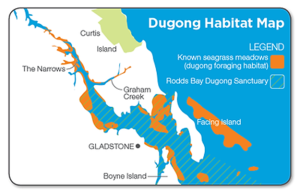Say hello to your friendly, local sea cow!
Gladstone is lucky to be home to dugongs, the mysterious mammals that may look like overweight dolphins but are more closely related to elephants.
 This map shows where you might be able to spot a dugong in the area. While dugongs are protected under many laws, Rodds Bay provides additional protection to the local dugong population.
This map shows where you might be able to spot a dugong in the area. While dugongs are protected under many laws, Rodds Bay provides additional protection to the local dugong population.
On this page you will find all the information you need to know about Gladstone’s favourite “sea cow”, as well as some simple ways you can help protect this iconic species. Have a look our activities page, which has lots of fun (and educational) activities for all the young (and old) Einsteins and Picassos out there — be sure to check out the fact sheets before you try the crossword!
Our top Dugong details!
Dugongs LOVE seagrass!
Dugongs love seagrass (particularly the eelgrass species found near Gladstone) and can eat up to 36 kilograms of these marine plants every day.
Dugong senses
Dugongs have small eyes and their eyesight that has been likened to the view a scuba diver has through their mask. However they have very good hearing, and use sensitive bristles or whiskers that cover their upper lip to find their food on the sea floor.
Dugong profile
| Diet | Herbivore |
| Habitat | Coastal areas |
| Diet | Herbivore |
| Life span | Known to live up to 70 years |
| Classification | Mammal |
| Endangered status | Vulnerable under Queensland’s Nature Conservation Act 1992 and Marine and Migratory under the Commonwealth Environmental Protection and Biodiversity Act 1999 |
| Scientific name | Dugong dugon |
